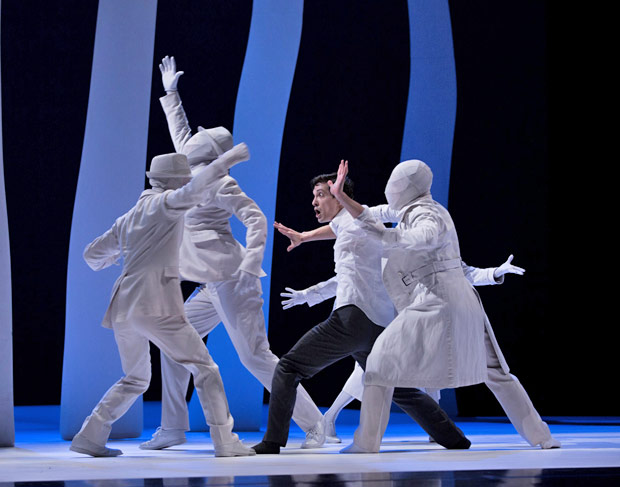
© Angela Sterling. (Click image for larger version)
Pacific Northwest Ballet
Her Story bill: Her Door to the Sky, Afternoon Ball, Plot Point
★★★★✰
Seattle, McCaw Hall
3 November 2017
www.pnb.org
www.mccawhall.com
Suspense be damned. I’m just going to give away the ending of this review: Crystal Pite’s Plot Point, which closes Pacific Northwest Ballet’s Her Story triple bill, is a terrific piece of dance-theater. Intelligent, original, fun to watch and, yes, suspenseful, Plot Point sets a bar for how many layers a dance work can encompass. It shares the Her Story bill with two other works by woman choreographers: Jessica Lang’s sunny Her Door to the Sky and Twyla Tharp’s unfortunate Afternoon Ball.
Created in 2010 on Nederlands Dans Theater, where Pite is associate choreographer, Plot Point is her experiment in rendering a written screenplay in wordless movement. For this restaging, she revised and tightened (from 47 to 32 minutes) the work in collaboration with PNB’s terrific dancers, who are divided into two camps: “Replicas” wearing all-white costumes and masks, representing tropes like the Femme Fatale (Leah Terada), the Straying Husband (William Lin-Yee), the Jilted Wife (Emma Love Suddarth), the Cuckolded Spouse (Kyle Davis) and Thugs (Lee and Davis); and full-color characters who flesh out those archetypes in a specific space and time: Leah Merchant, Karel Cruz, Lindsi Dec, Lucien Postlewaite, Ryan Cardea and Miles Pertl. James Moore, Noelani Pantastico, Benjamin Griffiths and Leta Biasucci completed the opening-night cast.
In an onstage interview the evening prior, Pite told PNB artistic director Peter Boal that the ballet has no plot per se, but a narrative emerges nevertheless: Conjuring midcentury, big-city America, the dancers wear slip dresses, trench coats, suits and fedoras and gather for a birthday cocktail party. Two married people are caught in an illicit affair, and their jilted spouses seek vengeance. Pite’s surprising and spot-on musical choice – excerpts from Bernard Herrmann’s sleekly dramatic score from the Alfred Hitchcock thriller Psycho, played live by the PNB Orchestra led by conductor Emil de Cou – perfectly supports the action.
Pite assigned the replicas two-dimensional, stop-motion movement that mixes breaking, mime and contemporary. Like puppeteers, the replicas lead the hapless characters into all manner of trouble, from passionate embraces, to handing briefcases of cash to hit men, to fistfights and emotional breakdowns. The fleshed-out characters feel the happiness, fear, abandon and abandonment that their amoral avatars can’t comprehend, but the replicas get the last word in a surreal final twist. These id-like forces are more powerful than we like to think.
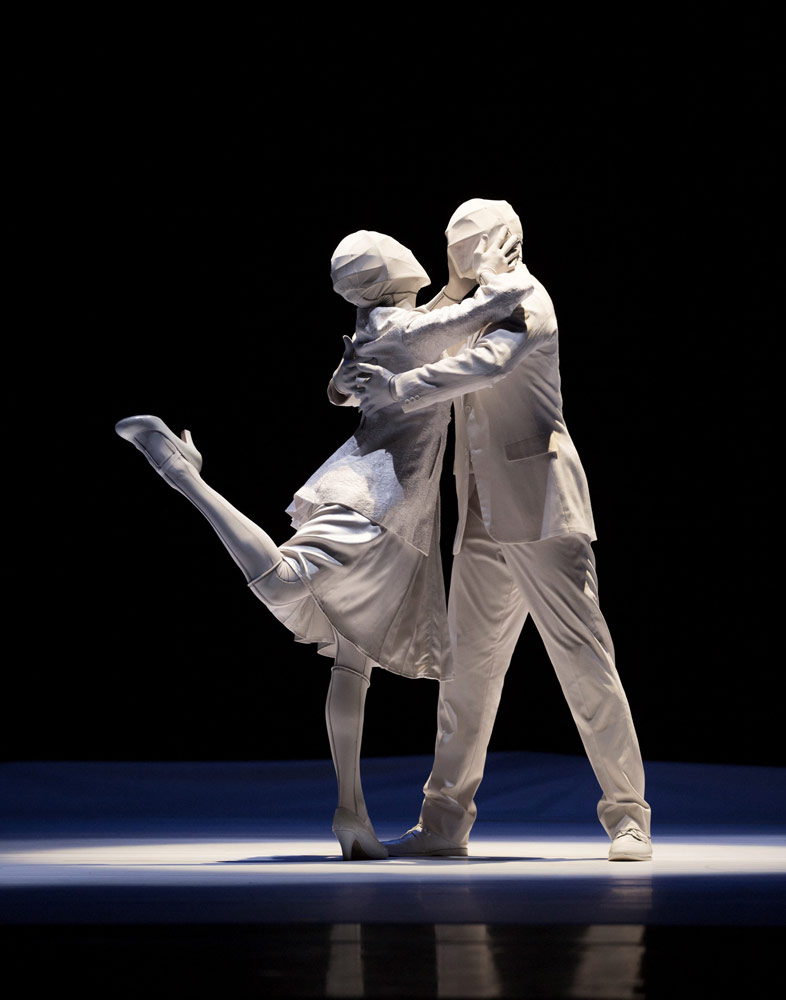
© Angela Sterling. (Click image for larger version)
The dancers dig into Pite’s expressionistic choreography, releasing any balletic inflections and personal mannerisms not essential to their characters, just as actors do. The replica dancers are arguably more remarkable for their embrace of an alien physicality, and their split-second timing with Owen Belton’s sound design of footsteps, doorbells and gunshots.
Pite’s team of collaborators built a maquette-style environment where the meta-story unfurls. Alan Brodie’s lighting plays right into Jay Gower Taylor’s cutout set pieces, which trace the façade of a house, streetlights and a thicket of trees. Layering so many visual and sonic elements belies Pite’s quest to represent words purely in movement: Plot Point is absolutely a Gesamtkunstwerk, but then so was Psycho.

Lang’s Her Door to the Sky pays homage to Georgia O’Keeffe’s “Patio Doors” paintings of the 1940s, in which the American painter rendered elevations of her home in Abiquiú, New Mexico. Co-commissioned by PNB and Jacob’s Pillow Dance Festival in 2016, the 21-minute piece will be performed on PNB’s 2018 tour to Paris.
The set re-creates O’Keeffe’s adobe façade under a turquoise-blue sky. A large central window serves an entry and exit point for Sarah Ricard Orza in a featured role that suggests a steel-spined pioneer woman. Four additional women and five men are her supporting cast, all dressed in Bradon McDonald’s dip-dyed costumes. Gathered skirts swirl around the women in swaths of color, and the full-coverage bodices are a rare sight on today’s ballet stage – they look almost liturgical in comparison.
Lang’s choice of music has a frisson of the prairie in it too. Benjamin Britten’s Simple Symphony, led by de Cou, has the same spirited, vernacular warmth of Aaron Copland’s score for Agnes de Mille’s Rodeo. Lang wanted to use that music, but switched to the Britten when she learned that O’Keeffe despised Copland. Lang’s choreography is in the vein of de Mille, rich in folksy inflections and balletic lyricism, alternately joyful and conflicted as it follows the music. Brief moments stand out, like Dylan Wald’s petit allegro solo and Jerome Tisserand’s last-second leap.
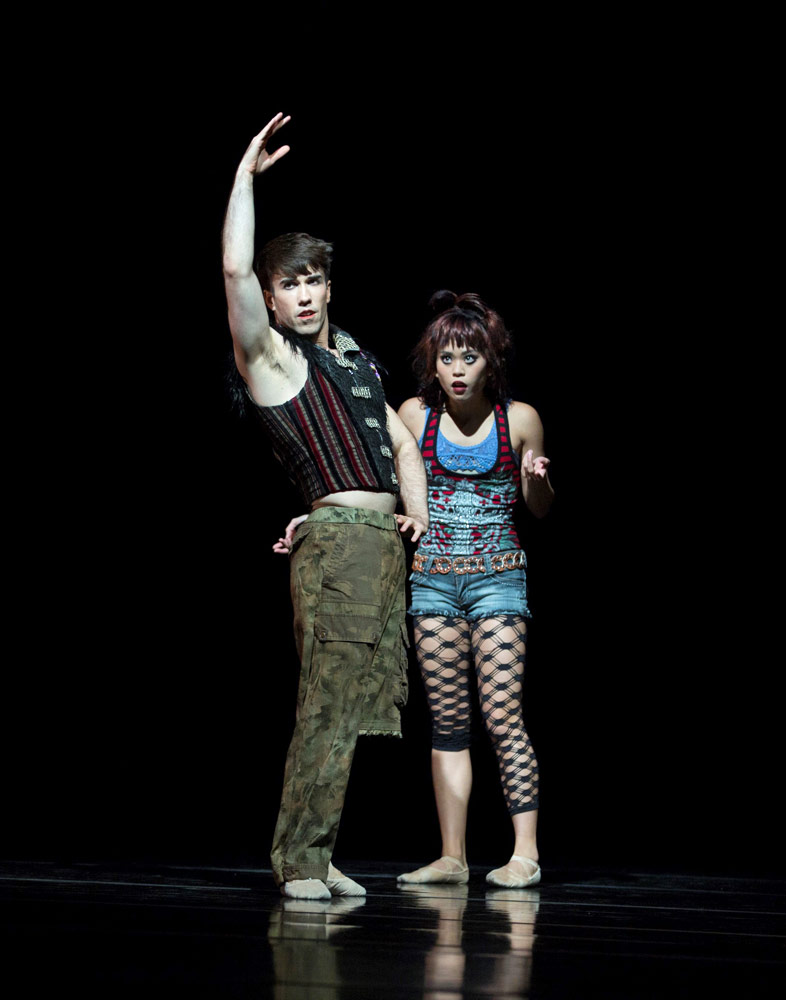
© Angela Sterling. (Click image for larger version)
If you haven’t got anything nice to say about Tharp’s Afternoon Ball, come sit by me. This shallow, 19-minute work about homeless youth, commissioned by PNB in 2008, spins an unintentionally laughable fairy tale of street life, where Judy Garland’s happy hobo meets Zoolander’s Derelicte.
Afternoon Ball has two things to recommend it: the minimalist string score Afternoon of the Elves by Vladimir Martynov (conducted by Allan Dameron) and PNB’s dancers. As Dumpster-diving guttersnipes, Angelica Generosa, Griffiths and Postlewaite gamely shimmy their heads, kick their heels and mime faux-befuddlement, like circus clowns looking into a cannon. Their costumes are as off the mark as the concept: cargo pants with one leg cut off do not a homeless person, or a compelling character, make.
The music eventually turns into a waltz for Laura Tisserand and Miles Pertl, elegantly attired in Regency-inspired gown and tails. Griffiths parallels their movement while gazing at them longingly as though peering from a frozen alley into a cozy living room; the character’s bourgeois longing is facile, but Griffiths dances with sincere, affecting desperation. Luckily for Tharp, the dancers are far better than this material, and they force you to find some value in it.








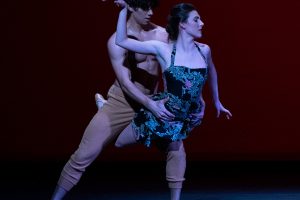
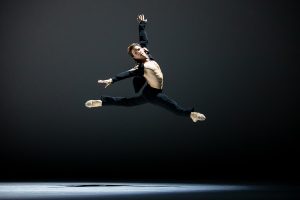

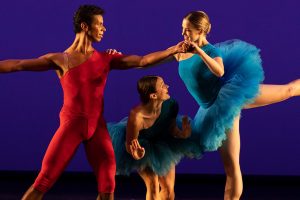

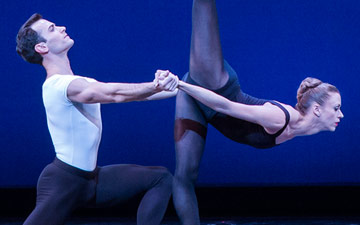
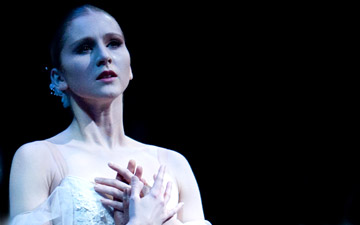
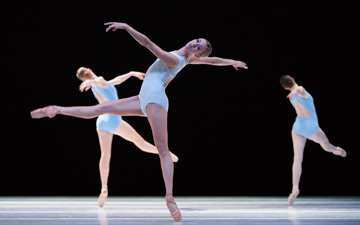

You must be logged in to post a comment.